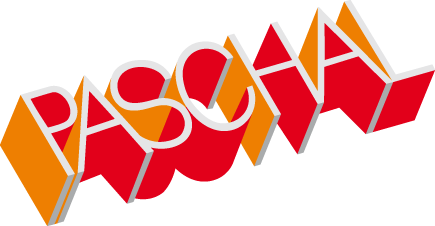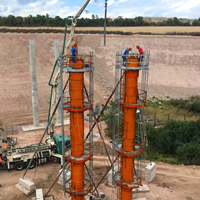Slender pillars for motorway bridge on the new A 44
Rädlinger Ingenieurbau uses circular column formwork from PASCHALThe motorway bridge near Herleshausen on the border between Hesse and Thuringia is to have slender, round pillars. This is why Rädlinger Ingenieurbau GmbH, the company responsible from Cham, decided in favour of the steel circular column formwork from PASCHAL.
It is probably one of the longest planning and construction periods for a motorway in the history of the Federal Republic of Germany. It was approved by the Federal cabinet in 1991, but the A44 motorway between Kassel and Eisenach has been under construction since 2000. Once completed, the motorway will serve as an important east-west link between the old and new federal states. Six of the twelve sections of the new construction, with a total length of around 70 kilometres, have been completed and five are under construction.
Deutsche Einheit Fernstraßenplanungs- und -bau GmbH, DEGES for short, is responsible for a section of the new motorway that is almost 30 kilometres long. For the construction of the section of the A 44 from the Waldkappel junction to the Wommener Dreieck interchange and the transition to the A4, it commissioned a consortium consisting of Josef Rädlinger Bauunternehmen and August Reiners Bauunternehmung in the area between the Riedmühle viaduct and the Wommener Dreieck interchange (5th construction phase). Rädlinger Ingenieurbau is responsible for the construction of the bridge at the Wommener Dreieck intersection, which leads from the A44 motorway to the A4 motorway in the direction of Frankfurt. In May 2023, construction work began on the ramp structure and with it the work on the formwork for the four piers of the viaduct.

The motorway bridge near Herleshausen in Hesse (structure 16) will become part of the new A 44. The 5th construction phase is expected to be completed in spring 2025. The high pillars were formed using PASCHAL circular column formwork.
Formed in two "shots"
PASCHAL circular column formwork with a diameter of one metre was used.
The four piers of different heights – they are between 13.80 metres and 15.50 metres high – were each formed in two cycles. Andreas Üblacker, Head of the Bridge Construction Department at Josef Rädlinger Ingenieurbau GmbH, was the project manager responsible for the construction of the piers. He explains the procedure for the "first shot" with a height of seven metres: "After the working scaffolding has been attached to the formwork, half of the pier formwork is placed. We then attach the pre-woven reinforcement cage to the connecting reinforcement, which rises about two metres from the foundation. Then we close the formwork."Two to three days after concreting is finished, the concrete has hardened and the seven metre high pillars are now firmly anchored to the ground. However, the formwork remains on the lower part of the pier while the second cycle is concreted. "Due to the slim crosssection with a diameter of one metre, the lower part of the formwork provides even more support," Mr Üblacker states.
The work on the formwork for the motorway bridge connecting the A 44 with the A 4 near Herleshausen – a total of eight concreting operations for the four piers – was completed within six weeks. "Whenever there was a gap, we added a pillar 'just like that'," the project manager recalls.
The advantage of steel formwork
The small pier diameter was one reason why the formwork solution from PASCHAL was used. "Steel formwork can absorb significantly higher concrete pressures and we are able to achieve a nice curve. If we had made a template from wooden elements ourselves, we would have ended up with a polygonal circle rather than a beautifully shaped curve," Mr Üblacker explains. And adds: "PASCHAL is one of the few suppliers to offer steel formwork with a diameter of one metre; competitors either only have wooden formwork in their portfolio or offer formwork for diameters up to 80 centimetres or then again from 1.50 metres."
The client and the design planners opted for a diameter of one metre in order to achieve harmonious, slender proportions, even if the concreting would be somewhat more challenging as a result. Larger pier diameters would result in significantly greater constraints on the structure's bearing system, and even slimmer ones would be problematic from an aesthetic point of view. The Rädlinger project manager already knew the PASCHAL's portfolio, as this was the second cooperation with the formwork manufacturer from Steinach. The circular column formwork was already used in 2019 to build the guest entrance for the Allianz Arena in Munich – an elevated platform. As a result, Mr Üblacker turned to the formwork consultant and head of the Lower Bavaria branch, Jürgen Fuchs, for the motorway bridge project in order to obtain a feasibility assessment and a quotation. "I originally became aware of the PASCHAL company because I had seen gantries on the motorways that stand on foundations with rounded ends. The manufacturer, who specialises in these signs, is a regular customer of PASCHAL and so they recommended the formwork company. That's how we came to work together on the Allianz Arena project," the head of the bridge construction department at Rädlinger relates.

Before the circular column formwork is erected and the reinforcement is threaded in, the working and safety platforms are installed on the ground.
Attention, power line!
What made the work on the ramp structure of the A44 motorway near Herleshausen a particular challenge was the fact that a high-voltage power line crosses the structure and therefore a safety distance had to be maintained during the concreting work. There was about twelve metres of space between the upper edge of the piers in their final state and the power line. "An altitude limit was set that we were not allowed to exceed. This is because power lines continue to sag depending on heat exposure," Andreas Üblacker explains. This meant that the first cycle could be concreted with the help of a concrete bucket attached to the crane. During the second concreting section, the concrete pump was used to ensure that no one entered the safety zone of the overhead line.
As soon as the weather permits this spring, the top of the bridge will be sealed with resin; then the caps will be concreted, which will serve as an emergency walkway for the motorway, among other things, before the asphalt carriageway between the kerbs completes the structure. Construction of the entire route section is scheduled to be completed in spring 2025. Due to the tunnel's operational equipment, it will not be possible to open the tunnel to traffic until 2026.





